15 Birds With Orange Chest

If you are a bird watcher, then this article is for you. Different birds have grabbed the attention of many bird watchers due to their vibrant and striking plumage. The different species of birds have their distinctive features in the avian world.
In this blog post, we will be exploring about 15 of the most beautiful birds with orange chests. Let us look at these magnificent birds.
List of 15 Birds With Orange Chest
- American Robin
- Baltimore Oriole
- Western Tanager
- Orchard Oriole
- Bullock’s Oriole
- Flame-colored Tanager
- Blackburnian Warbler
- Hooded Oriole
- Scott’s Oriole
- Summer Tanager
- Northern Cardinal
- Eastern Towhee
- Varied Bunting
- Painted Bunting
- Blue Grosbeak
1. American Robin (Turdus migratorius)

Description:
The American Robin bird name was kept after the European Robin. They are not closely related but belong to the family of Old-World flycatchers. It is a bird that has a reddish-orange breast.
They also have pointed yellow dark-tip bills and a throat that is white with black streaks. American Robins have black to gray heads, tails, and bellies are white, and their eyes are white around.
Habitat:
The migratory bird, American Robin is generally found in North America. During their winter season, they also migrate from southern Canada to central Mexico along the Pacific coast. These birds reside in open farmland, woodland, and urban areas.
Feeding:
Primarily, their diet consists of small invertebrates (such as beetle grubs, caterpillars, grasshoppers, and earthworms), and fruits like berries. American Robin feed in flocks. These birds can find the earthworms simply by using their listening skills. Its main predator is the domestic cat.
2. Baltimore Oriole (Icterus galbula)
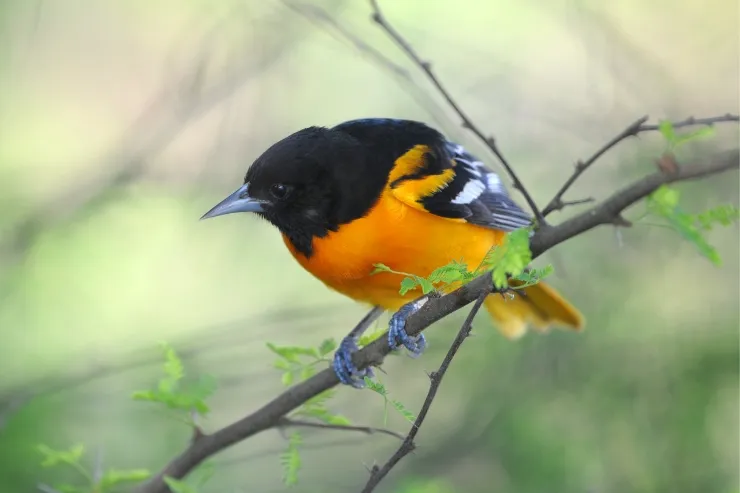
Description:
Baltimore Oriole is a bird with an orange chest. This beautiful Oriole bird is a state bird of Maryland. Their body structure is typically built of icterids that have a sturdy body, fairly long legs, a thick pointed bill, and a long tail.
Regarding size, male Oriole are larger in comparison to female Oriole. The adult male has an orange underparts, shoulder patch, and rump.
Along with that, male plumage is black. Whereas, the adult females have darker wings with yellow parts on the upper parts. It also has dull orange-yellow on the belly and breast.
The size ranges from 17–22 cm (6.7–8.7 in), weighs around 22.3 to 42 g (0.79 to 1.48 oz), and wingspans are 23–32 cm (9.1–12.6 in).
Habitat:
A small icterid bird, the Baltimore Oriole is commonly found in the eastern United States to the central and southern America.
During the summer season, they reside in the Nearctic and migrate to the Neotropics in the winter. This medium-sized passerine bird is a rare vagrant in the Western part of Europe.
Most often these birds are seen in open woodland, forest edges, wooded wetlands, farmland, urban parks, orchards, and suburban landscapes. It is also found in leafy deciduous trees but cannot live in deep forests.
Feeding:
Baltimore orioles prefer to eat ripe and dark-colored fruit. Fruits like reddest cherries, darkest mulberries, deepest-purple grapes, etc. Besides this, they also feed on wasps, bugs, beetles, spiders, and grasshoppers.
3. Western Tanager (Piranga ludoviciana)
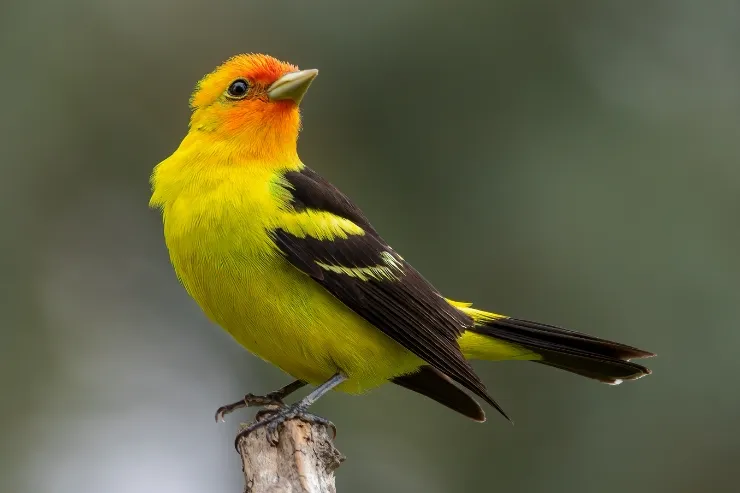
Description:
The Western Tanager is an American medium-sized songbird that presently belongs to the Cardinalidae family. These species of birds have similar vocalizations and plumage related to other cardinal families.
The adult male has a bright red face, and an olive tinge body, with a black upper back, shoulder, and rump. Similarly, the adult female has an olive back, yellow head, dark wings, and tail.
Size, Weight, and Wingspan of Western Tanager:
Size: 16–19 cm (6.3–7.5 inches)
Weight: 28–43 g (0.8-1.3 oz)
Wingspan: 29 cm (11.5 inches)
Habitat:
These birds mainly habitat in open mixed woodlands or coniferous forests. The Western Tanager are found across western North America from Mexico United States as far as southern Alaska. They also migrate from Central Mexico to Costa Rica.
Feeding:
Regarding their diet, they eat a wide range of insects and fruits. These birds foliage by hawking and gleaning. As per some of the reports it is also disclosed that they forage on Perry’s agave nectar.
4. Orchard Oriole (Icterus spurius)
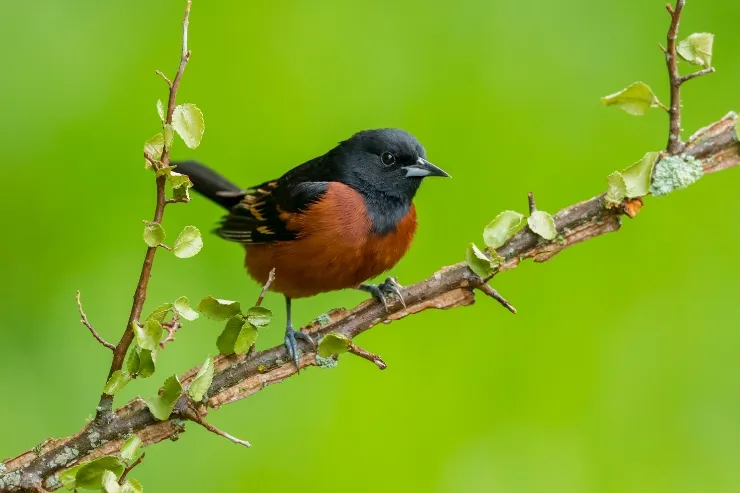
Description:
Orchard Oriole is a nocturnal migrant. It is also recognized as the smallest species of icterid which is called Fuertes’s Oriole or Ochre Oriole. Typically, if we observe these birds, they have a pointed bill, and the lower mandible is black with some blue-gray.
Males’ plumage is black and has chestnut on the underparts, rump, and shoulder, and blackheads. Whereas the adult female upperparts are olive-green, and their breast and belly are yellowish.
Habitat:
These birds mostly habitat in open areas and prefer to live in shaded trees such as deciduous trees with parks that include lakes and streams. Orchard Oriole is found across eastern North America to central Mexico.
Being a migratory bird, it ranges from the coastal lowlands of central Sinaloa and southern Veracruz to northern Venezuela and Columbia.
Feeding:
A species of Icterid, Orchard Oriole’s diet consists of fruit, insects, and spiders.
5. Bullock’s Oriole (Icterus bullockii)
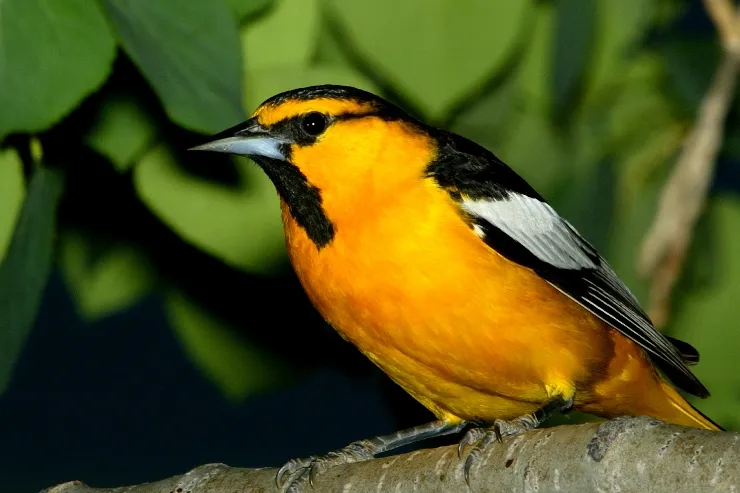
Description:
Bullock’s Oriole is also one of the species of bird that has an orange chest. This bird’s name was given after an English amateur naturalist, William Bullock. These birds are sexually dimorphic.
Adult males have an orange and black plumage, a long tail, and a pointed bill with straight culmen. Adult females have dulled yellow on the breast and underparts, gray, and brown in upper parts, and olive in the crown.
Size, Weight, and Wingspan of Bullock’s Oriole:
Size: 17–19 cm (6.7–7.5 inches)
Weight: 28–43 g (1.0–1.5 ounces)
Wingspan: 31 cm (12.2 inches)
Habitat:
Being a family of Icteridae, Bullock’s Oriole prefers to live in open deciduous woodland, riparian corridors, and scrub forests.
At the time of the breeding season, they mostly prefer pecans, cottonwood, and willow. These birds are native to western North America. Bullocks are vagrants in the eastern part of the continent.
Feeding:
Bullock’s Oriole is a small bird which forages in shrubs and trees. Their main diet consists of berries, fruits, nectar, and insects. The source of nectar is mainly obtained from eucalyptus trees in California. Shortly, they fly to catch the insects.
6. Flame-colored Tanager (Piranga bidentata)

Description:
An American songbird, the Flame-colored Tanager is a medium-sized bird that has a distinct red-orange color in the male head and underparts. Along with that, this male bird has a small brown patch below the eye from the bill.
The beautiful female bird has a yellow head and underparts, and their back part is olive with black streaks. Formerly, these birds were known as the stripe-backed tanager.
Habitat:
Their habitat is mainly in large trees in non-forested areas. Such as coffee plantations, pastures, and gardens. The flame-colored tanager is found in open oak and pine-oak woodlands. They reside occasionally in the United States. Apart from this, it is found from Mexico to northern Panama.
Feeding:
Their diet consists of a variety of berries and small arthropods. The Flame-colored Tanager forages in pairs or alone.
7. Blackburnian Warbler (Setophaga fusca)
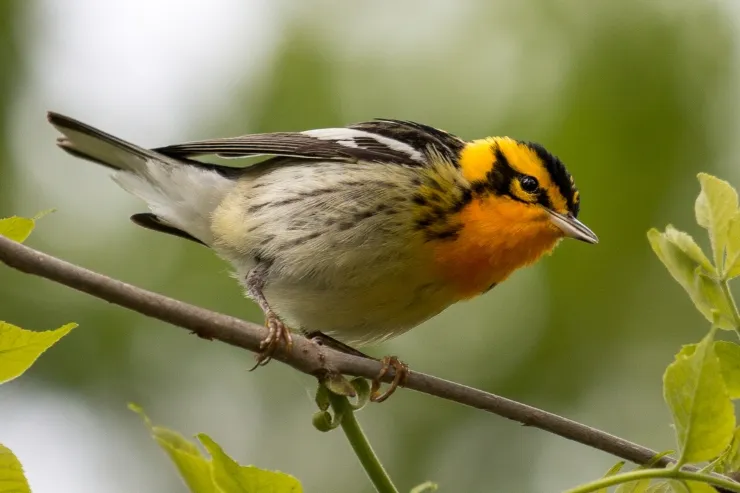
Description:
The Blackburnian Warbler is a small migratory bird that was named after an English botanist, Anna Blackburne. It is an average-sized passerine bird. Males have dark gray backs and double white wing bars.
Their crown is dark brown, yellow rumps, and underparts are white and tinged with yellow and streak black. It also has yellow and black heads and bright orange throats. While the adult female is duller than the adult male.
Habitat:
A small bird, the Blackburnian Warbler forages in lower levels of coniferous trees. This fascinating bird is commonly found in eastern North America, from Southern Canada to North Carolina. During the winter, they migrate to southern Central America and South America.
Feeding:
Their diet primarily consists of insects such as caterpillars, but they receive supplements from spiders.
8. Hooded Oriole (Icterus cucullatus)

Description:
The Hooded Oriole is a medium-sized New World Oriole bird belonging to the Icteridae family. These birds have curved bills and white and black wing bars.
The adult males have black on the back, wings, and tail, and a deep yellowish orange head with black on the face and throat. Their underparts are orange. Likewise, female adults have olive green on the upper parts and their breasts and belly are yellowish.
Habitat:
Their habitat is mainly in open areas with trees like palms, generally found in Northern Mexico and Southwestern United States.
Feeding:
Regarding their diet, Hooded Orioles are known to be an acrobatic feeder. They mainly feed on berries, nectar, and insects. These birds forage in trees and shrubs.
9. Scott’s Oriole (Icterus parisorum)
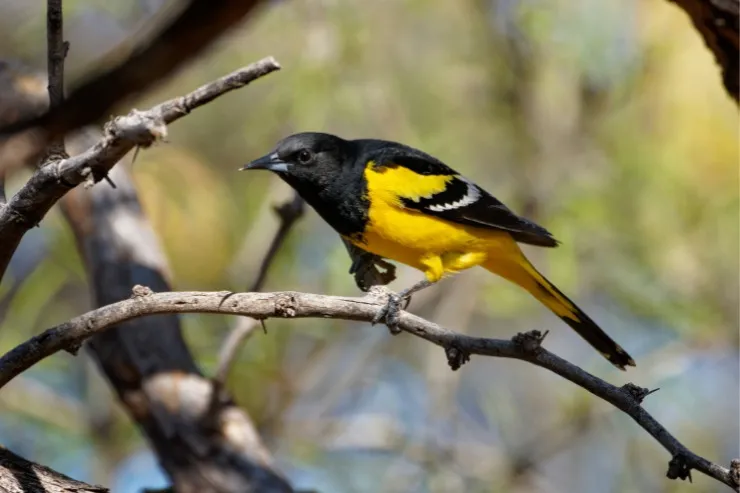
Description:
Scott’s Oriole is a medium-sized icterid bird belonging to the Icteridae family. Their distinctive feature is white wing bars, vivid yellow on the lower parts, and velvety black on the upper part of adult males.
Habitat:
These species of birds are commonly found in Sacramento and southern California. Besides this, it is also found in the southwestern United States to California Sur and Central Mexico.
Feeding:
Feeds mostly on fruits, nectars, and insects. This bird mainly forages on the ground in pairs or small groups and weaves its nest from dead leaf clusters.
10. Summer Tanager (Piranga rubra)
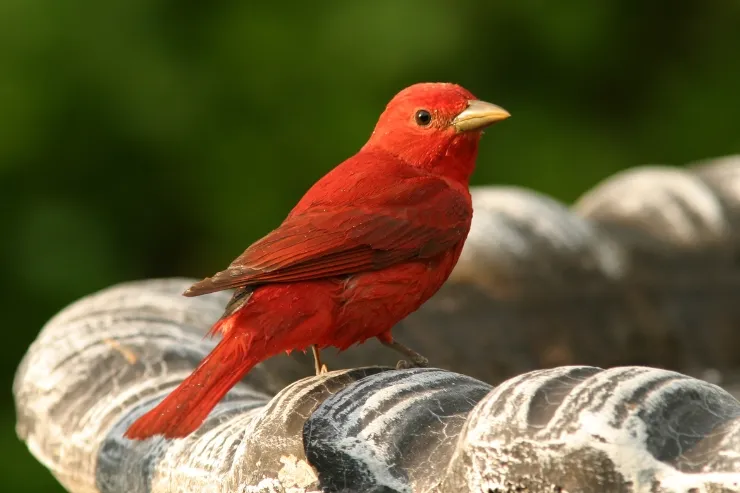
Description:
A medium-sized American songbird named Summer Tanager presently belongs to the Cardinalidae family. But before that, it was in the Tanager family. They have stout pointed bills. These species of male birds have hepatic tanager appearance and dark bills. The adult female has orange underparts, olive-brown wings, and tails.
Habitat:
Summer Tanager habitat in open wooded areas such as with oaks. In Western Europe, this bird is an extremely rare vagrant. They migrate to Central America, Mexico, and Northern South America.
Feeding:
Their diet consists of insects (such as wasps, and bees), and berries. They forage in the high trees to catch the insects in flight.
11. Northern Cardinal (Cardinalis cardinalis)
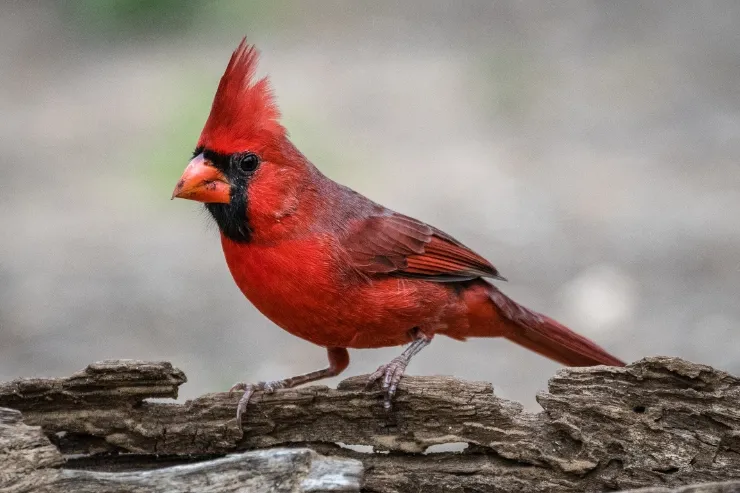
Description:
It is a mid-sized perching songbird which is commonly called the redbird, red cardinal, common cardinal, or cardinal. The Northern Cardinal birds belongs to the Cardinalis genus.
Size, Wingspan, and Weight of Northern Cardinal:
Size: 8.3–9.3 inches (21–23.5 cm)
Wingspan: 9.8–12.2 inches (25–31 cm)
Weight: 1.19–2.29 ounces (33.6–65 g)
Habitat:
Throughout the year, the Northern Cardinals inhabit the dense area which is interspersed with open areas. Such as brushy fields, parks, woodland edges, wooded wetlands, and suburban areas.
Feeding:
Primarily, they eat weed seeds, grains, and fruits. These birds also consume cicadas, beetles, and grasshoppers.
12. Eastern Towhee (Pipilo erythrophthalmus)
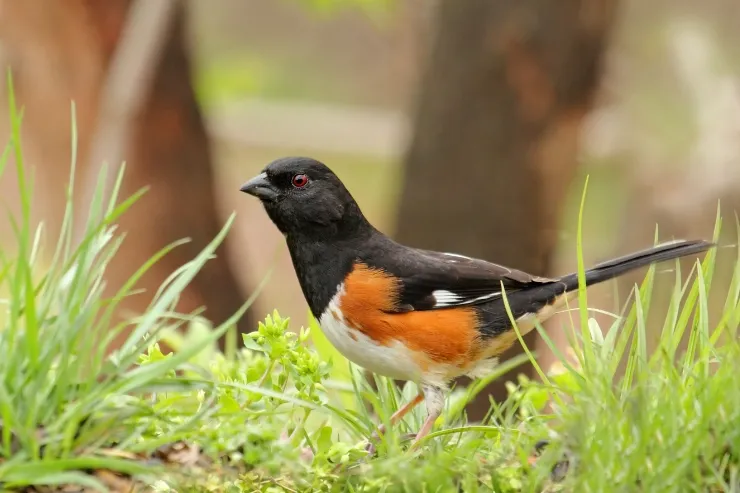
Description:
Eastern Towhee is a large New World Sparrow that has a distinct striking species of sparrow. The male birds have a black head, tail, and upper body. However, these parts of the female birds have a brown color.
Habitat:
Mainly, Towhees occur in the habitats of the tallgrass prairies and marshes to mature forests. It is found in the brushy areas across eastern North America, along the border of Tennessee and North Carolina.
Feeding:
These birds eat a variety of plants and animals. Such as seeds and fruits, invertebrates, small amphibians, snakes, and lizards. Primarily, they eat on the ground. While foraging on the ground, Eastern Towhee uses a technique of scratching where both feet simultaneously kick back.
13. Varied Bunting (Passerina versicolor)
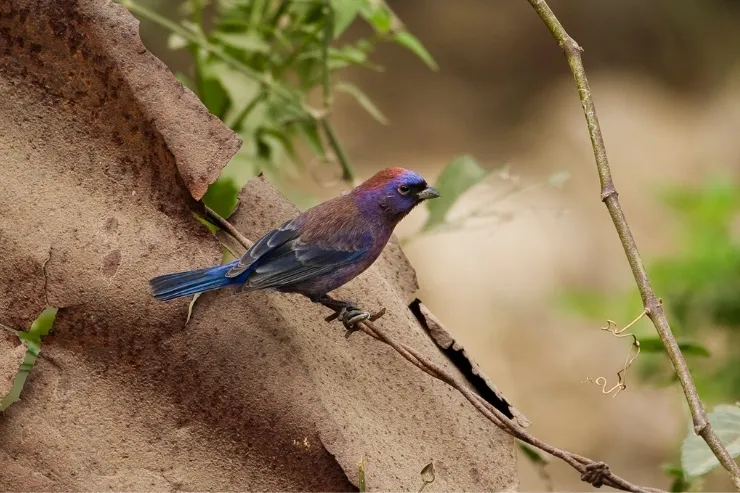
Description:
Varied Bunting is a songbird that belongs to the family of Cardinalidae. This bird has a rounded bill and a short tail. At the time of the breeding season, male birds have a bright red patch on the nape whereas the females are plain light brown and lack streaks on their breasts.
Habitat:
This bird mainly ranges from the Southern part of Arizona, Texas, New Mexico, and Oaxaca. The Varied Bunting prefers scrubby woodlands, thorn forests, thorny brush thickets, and overgrown clearings.
Feeding:
Mostly, it has been observed that these species of songbirds often forage in pairs (i.e. in small flocks) during the winter season. Throughout the year, these lovely birds eat seeds, insects, seed pots, and cactus fruits.
14. Painted Bunting (Passerina ciris)
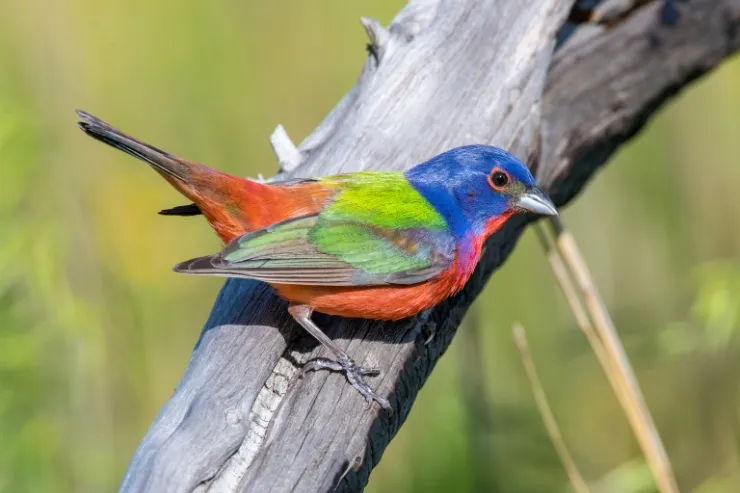
Description:
The Painted Bunting bird is also called the Mexican canary, pope, painted finch, or nonpareil. It is a bird that is natively found in North America. It is quite easy to distinguish this bird due to its colors, dark blue head, green back, red rump, and underparts.
The adult male has bright plumage which appears only in the second year of life. Similarly, the adult female plumage comes in the first year which can be identified by close inspection.
Habitat:
As of now, these birds are found in thickets, woodland edges with riparian thickets, shrubbery, and brushy areas. The beautiful Painted Bunting bird is mainly found in coastal Georgia, Arkansas, Texas, Oklahoma, Northern Florida, and Louisiana. They occasionally migrate to Pennsylvania, New York, and New Jersey.
Feeding:
These species of birds mainly feed by hopping along the ground. During the breeding and nesting season, the Painted Bunting bird eats snails, spiders, insects like grasshoppers, and caterpillars. Bunting birds regularly eat seeds of grasses.
15. Blue Grosbeak (Passerina caerulea)

Description:
Blue Grosbeak is a medium-sized passerine bird which has distinct features. It is a bird under which both sexes are distinguished by double wing bars and a large, deep bill. The male bird has a deep blue, with both black and brown on its wings. Whereas, the female blue grosbeak is mostly brown.
Habitat:
In the family of Cardinalidae, the Blue Grosbeak is a migratory bird found in the southern half of the United States. These species of birds are also found in open habitats, such as cultivated lands, woodland edges, scattered trees, scrub, thickets, or hedgerows.
Feeding:
Primarily, the Blue Grosbeak is a species of bird that mostly eats insects. They forage on the ground. Such as spiders, snails, grains, seeds, and wild fruits.






